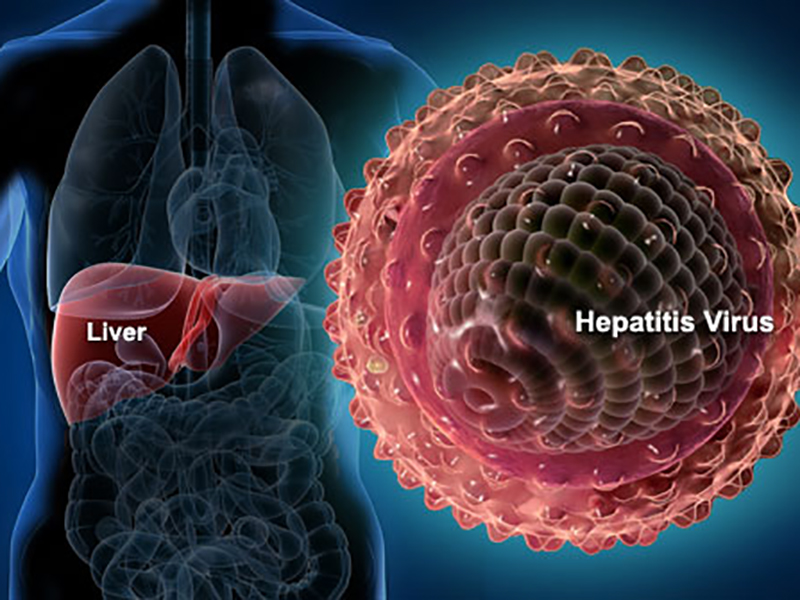What are Viral Hepatitis and what risks are those affected by it: they are divided into 5 groups, each of which can give different signs, symptoms and adverse events.
The Epatiti Virali – according to what theHigher Institute of Health – are infectious processes affecting the liver. They which, despite having similar clinical pictures, differ from the etiological point of view (different viruses responsible for the infection), epidemiological (different distribution and frequency of infection and disease) and immuno-pathogenetic.
In Italy, epatiti is understood between illnesses for which mandatory notification is required (Class II, significant diseases because of high frequency and subject to control interventions).
In about 10-20% of cases the agent responsible for hepatitis remains unknown. In the last decade of the last century other viruses potentially involved in these infectious processes have been isolated, such as the F virus, the G virus which, although responsible for human infection, only in some cases appears clearly associated with disease, the TT virus, frequently isolated in patients with various types of hepatic pathologies as well as in healthy subjects, and lately the SEN virus, isolated in subjects with viral hepatitis.
There are also other viruses, which in addition to the underlying disease can sometimes cause hepatitis of varying severity. These are called minor hepatitis viruses and are mainly: cytomegalovirus, Epstein-Barr virus, Coxsackie virus and herpesvirus.
To date, there are 5 types of viral hepatitis determined by the so-called major hepatitis viruses.
Let’s find out in detail:
Hepatitis A.
The virus responsible for hepatitis A (Hav) is a picornavirus classified as a prototype of the new genus of Hepatovirus. The disease has an incubation period ranging from 15 to 50 days and a generally self-limiting and benign course. Asymptomatic forms are also frequent, especially during epidemics and in children.
However, sometimes there can be more severe forms with a protracted course and also rapidly fatal fulminant forms. The disease is lethal in a percentage of cases that is between 0.1% and 0.3%, but can reach up to 1.8% in adults over 50 years of age. Usually the disease, which lasts 1-2 weeks, manifests itself with fever, malaise, nausea, abdominal pain and jaundice, accompanied by elevations of transaminases and bilirubin. A proportion of infections, especially if contracted at a young age, remain asymptomatic. Patients recover completely without ever becoming chronic; therefore, there is no chronic carrier of virus A, either in the blood or in the faeces.
Transmission and dissemination.
Transmission occurs via the fecal-oral route. The virus is present in the stool 7-10 days before the onset of symptoms and up to a week later, while it is present in the blood for only a few days. Generally, the infection occurs by direct contact from person to person or through the consumption of water or some raw (or not sufficiently cooked) foods, especially molluscs, raised in water contaminated by sewers containing the virus. Cases of contagion due to blood transfusions or derived products have only rarely been observed.
Hepatitis A is widespread throughout the world in both sporadic and epidemic forms. In developing countries with poor sanitation conditions, the infection is transmitted rapidly among children, in whom the disease is often asymptomatic, while many adults are already immune to the disease. In the most advanced countries, on the other hand, in recent years there has been an increase in the proportion of symptomatic cases because, in better sanitation conditions, children and young adults rarely come into contact with the virus and consequently the average age of cases increases .
Vaccine.
In Italy, two different vaccines are available that provide protection from infection already after 14-21 days. Vaccination is recommended in those at risk, including those traveling to countries where hepatitis A is endemic, for those who work in environments in contact with the virus, drug addicts, and family contacts of people with acute hepatitis A. vaccination is also recommended for those suffering from chronic liver disease, as the lethality in these subjects is greater. The general hygiene rules for the prevention of fecal-oral infections and the control of the cultivation and marketing of seafood are also very important.
Hepatitis B.
The hepatitis B virus (Hbv) is a DNA virus belonging to the family of Hepadnaviridae. Currently, 6 genotypes (AF) are known having a different geographical distribution. Hbv infection is, in most cases, asymptomatic. On the contrary, the evolution of the infection into a disease presents insidious onset with abdominal discomfort, nausea, vomiting and sometimes with jaundice accompanied by fever of live entity. However, only 30-50% of acute infections in adults and 10% in children lead to jaundice. The fatality rate is about 1%, but the percentage increases in people over the age of 40.
In adults, the disease becomes chronic in about 5-10% of cases. The risk of becoming chronic increases as the age at which the infection is acquired decreases; in fact, in infants infected shortly after birth, it occurs about 9 times out of 10. In 20% of cases, chronic hepatitis can progress to liver cirrhosis over a period of about 5 years. Liver cancer (hepatocellular carcinoma) is another common complication of chronic hepatitis, especially in patients with cirrhosis. Hbv infection in highly endemic countries is responsible for up to 90% of liver carcinomas. The source of infection are those with acute illness or chronic carriers, in which the virus persists in the blood and other biological fluids, such as saliva, bile, nasal secretions, breast milk, sperm, vaginal mucus.
Transmission.
Transmission occurs by apparent parenteral route, that is through transfusions of blood or blood products contaminated by the virus, or by cuts / punctures with infected needles / instruments, sexual and perinatal from mother to child. Furthermore, since the virus resists on environmental surfaces for at least 7 days, the infection can also occur through inapparent parenteral route (indirect inoculation) or through contaminated vehicles through minimal lesions of the skin or mucous membranes (dental brushes, scissors, combs, razors , bath brushes contaminated with infected blood). The transmission by way. However, the risk of contagion by transfusion, although still present in developing countries, has been practically eliminated in industrialized countries, by virtue of the checks carried out on donated blood and subsequent processing processes capable of destroying the virus.
At risk, therefore, are drug addicts, those who practice unprotected sex, health workers in contact with infected people or who work in the laboratory in contact with the infectious agent; family and sexual contacts of infected people are also at risk, and all those practices that involve the use of non-sterilized needles and syringes, such as tattoos, piercings, manicures, pedicures.
The incubation period varies between 45 and 180 days, but is usually between 60 and 90 days.
Hepatitis B and vaccine.
The vaccine currently in use is genetically engineered, has been shown to be safe and effective, and provides long-lasting immunity.
In Italy, vaccination has been compulsory for all newborns since 1991 and, until 2003, it was also compulsory for adolescents aged 12.
Hepatitis C.
The infectious agent is a hepacavirus (Hcv), belonging to the family of Flaviviridae, of which six different genotypes and over 90 subtypes have been identified. The implication of these genotypic variations in the clinical course of the disease is still not clear, but there are certainly differences in the response of the different genotypes to antiviral therapies.
Initial acute Hcv infection is in most cases asymptomatic and anitteric. In those clinically presenting the disease, onset is insidious with anorexia, nausea, vomiting, fever, abdominal pain, and jaundice. A fulminant fatal course is very rarely observed (0.1%), while a high percentage of cases, estimated up to 85%, will undergo chronicization. 20-30% of patients with chronic hepatitis C develop cirrhosis over 10-20 years and, in about 1-4%, subsequent hepatocellular carcinoma. The incubation period is from 2 weeks to 6 months, mostly it is between 6 and 9 weeks.
Transmission occurs mainly through the parenteral route. Sexual infection is possible, but this route appears to be much less efficient than for HBV. Infection can be transmitted vertically from mother to child in less than 5% of cases. The control of blood donations, through the test for the detection of anti-Hcv antibodies, has considerably reduced the risk of infection following blood transfusions and blood products.
To date, there is no vaccine against hepatitis C and the use of immunoglobulins has not proved effective. Effective prophylactic measures are represented by general hygiene rules, the sterilization of surgical instruments and for aesthetic treatments, the use of disposable materials, protection in sexual intercourse at risk.
Hepatitis D (Delta).
The infectious agent of hepatitis Delta is known as HDV: it is classified among the so-called satellite viruses, or subvirions, which require the presence of another virus to be able to replicate.
Mode of infection.
In order to infect liver cells, the hepatitis D virus requires the help of the hepatitis B virus in particular, so the infection occurs in subjects also affected by Hbv.
Infection can occur in two ways:
- simultaneous infection with viruses B and D. In this case, hepatitis clinically similar to hepatitis B occurs
- D virus superinfection in a chronic HBV carrier. A new, sometimes fatal, acute hepatitis occurs.
Studies have shown that 25-50% of fulminant hepatitis cases in Europe and the US were actually caused by HDV. In both cases the infection can become chronic and in this case it generally has a more severe course than that of the B virus.
The mode of transmission is the same as in hepatitis B and the incubation period is 2 to 8 weeks.
Exist 3 genotypes of Hdv:
- genotype I is the most widespread, all over the world.
- genotype II was detected in Japan and Taiwan.
- Genotype III is present only in the Amazon.
An estimated 10 million people are affected by hepatitis D and its supporting virus.
As for preventive measures, Hbv prophylaxis applies: the hepatitis B vaccine can also protect against hepatitis D.
Hepatitis E.
The infectious agent of hepatitis E, the Hev virus, has been provisionally classified in the family of Caliciviridae. Hepatitis E is an acute disease that is often anitteric and self-limiting, very similar to hepatitis A. In rare cases, hepatitis E can result in a fulminant form leading to death. The fulminant forms occur more frequently in pregnant women, especially in the third trimester of pregnancy, with lethality of up to 20%. Although rare, chronic cases are reported in immunocompromised individuals and cases of exacerbation are also reported in the literature.
As with hepatitis A, transmission occurs via the fecal-oral route, and faecal-contaminated water is the primary vehicle for infection. The incubation period is from 15 to 64 days.
Hepatitis A is present all over the world, mainly in geographic areas with inadequate hygiene levels. In industrialized countries, on the other hand, the majority of cases involve people returning from travel to endemic countries. However, the number of indigenous cases is increasing in industrialized countries.
Regarding prevention, the administration of gammaglobulins, especially in pregnant women, is being demonstrated.
Experimental clinical trials are underway for the marketing of two vaccines. See also the in-depth analysis “Hepatitis E in Italy: under special surveillance through the Seieva”By Maria Elena Tosti and Valeria Alfonsi (coordination Seieva, Iss).
–

/data/photo/2019/09/15/5d7d62539a8dc.jpg)
